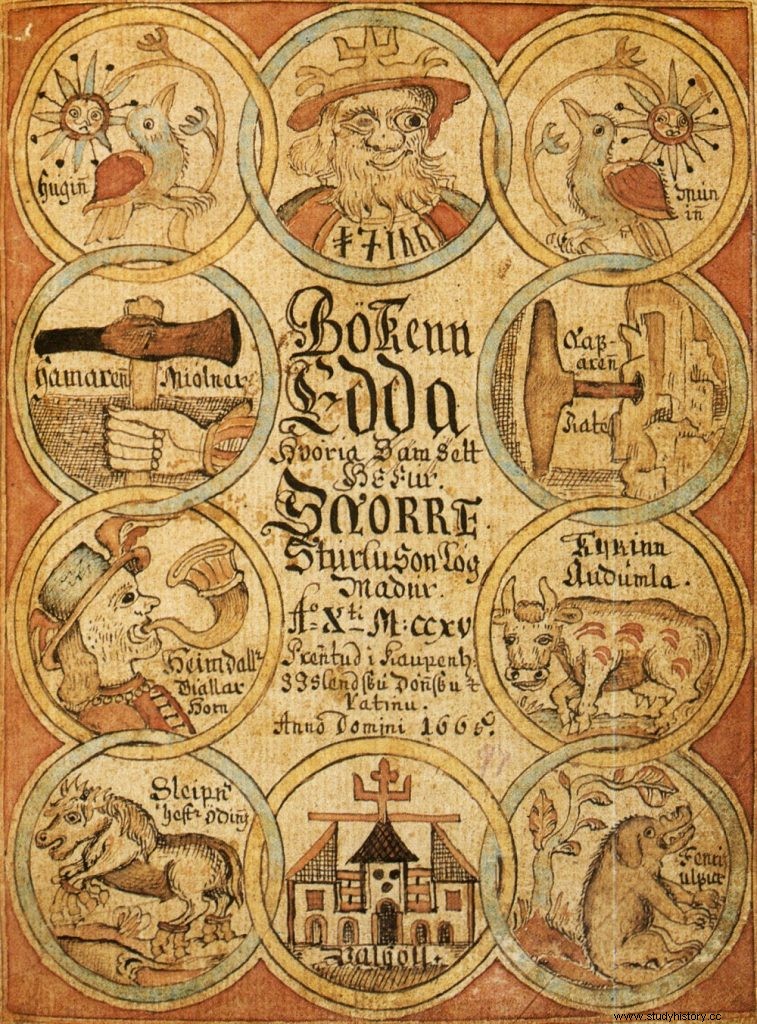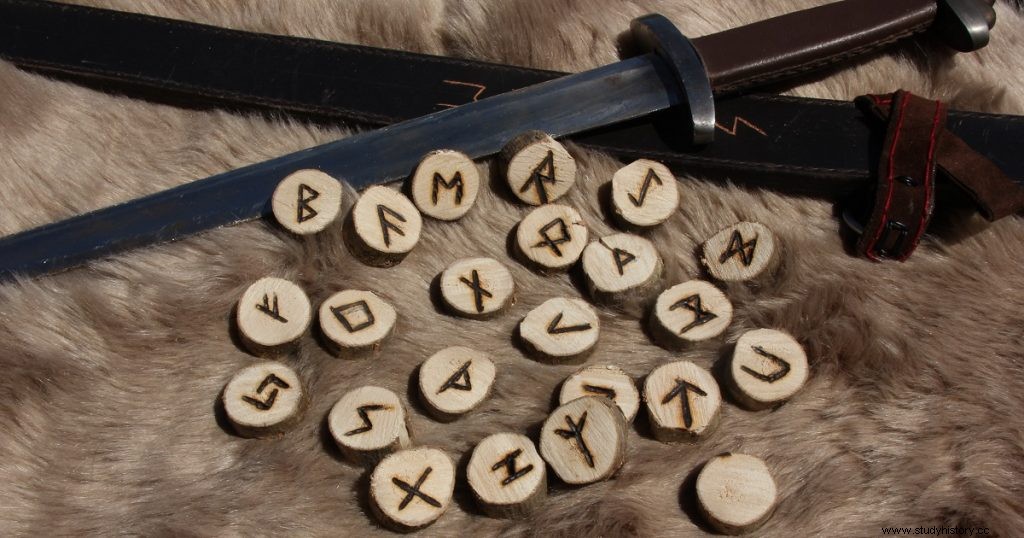“Do you know how to scratch? Do you have any advice? Do you know how to sacrifice?" If you want to know, look in the Edda. The standard work for Nordic mythology is, in addition to rune lore, also the source of the Nibelung saga, whose heroes live and die along the German Rhine. Almost incidentally, the gods give good advice for surviving drinking bouts or transporting gold treasures.
Norse mythology and its main works:Songs Edda and Snorra Edda

Edda refers to the entire compilation of stories, some of which go back to the 9th century but were written down much later. The stories are handed down in two books
– Songs Edda with legends of gods and heroes, and the
– Snorra-Edda, the textbook of singers and poets (Skalds).
The two books Lieder-Edda and Snorra-Edda are the most important sources for Norse mythology today. The Song Edda is also sometimes referred to as the "Older Edda", although this tends to lead to confusion. It contains songs of the gods, e.g. B. to the god Odin, and heroic songs, like those of the Nibelungen. The bottom line is that Nordic mythology often advises moderation in the songs of the gods:celebrate less and if in doubt, keep your mouth shut.
The Snorra Edda, sometimes imprecisely called the Younger Edda or the Prose Edda, is the handbook for skalds. These were the poets and singers of the north. The term "Younger Edda" is misleading as both versions were written in the 13th century. It arose because it is assumed that the author of the Snorra Edda, Snorri Sturluson, must have known the texts of the Song Edda. The term Prose Edda is also not entirely appropriate, since the Snorra Edda also contains exemplary stanzas between the prose texts.
The Edda Songs – Songs of the Gods and Heroes
For Norse mythology, the Song Edda is the most important tradition. Depending on the interpretation, it is divided into 29 to 37 songs of the gods, plus the heroic songs and two pieces of prose. The most important and comprehensive tradition of the 63 stanzas comes from the Codex Regius, the "king book" from the 13th century. However, the stories are much older and were only passed down orally for a long time. The Song Edda is also sometimes referred to as the Saemundar Edda, since until the 19th century it was believed that the texts were written by the Icelandic priest Sämundr inn Frodhi. However, this was refuted, so that this term is rather avoided today.
The gods in the Song Edda
Norse mythology describes gods from the Aesir and Vanen families. They created the world, but then got into an argument about Gullveig, a Vanian goddess in Germanic mythology.
The visionary songs tell of a long past. Even then, the end of the world and a new world occupied the minds of singers and listeners. The first and most important of the 16 songs of the gods from the first part of the Song Edda is the Völuspá (Icelandic), translated as “Prophecy of the Seer”.
Ragnarok and the End of the World
In the alliteration typical of the Edda, the seer tells of the creation and end of the world (Ragnarok) and a new creation associated with it. The seer also knows exactly how the gods managed to create the world and bring order to the universe:First the dwarves were created, then the first humans followed. Norse mythology tells us that every human being's destiny is anchored in a root of the world tree. This tree is the Yggdrasil ash.
Gods tips for the time until doom
After the end of the world, Norse mythology describes a new world with a golden age for gods and humans. Until then, the songs of the gods give good advice on how to lead a life that is as solid as possible. The Hávamál, the Song of Songs or Odin's Rune Song, is about such wisdom. Hávamál collects all sayings about a good, just, and moderate life:
"Long to the cup, but empty it with measure,
Speak well or be silent.
Nobody will call it a vice
If you go to rest early”
Hávamál (18), translated by Karl Joseph Simrock
Gods explain the runes
Runes are an important theme in the Song Edda. For example, in the song of the gods Hávamál, it is reported how Odin sacrificed himself in order to gain knowledge of the runes:He hung upside down from the world ash Yggdrasil for nine days. In addition, the magical powers inherent in the runes are described, as well as 18 spells.
The runes were sticks with signs carved into them. Many of the rune animals are snake-like, as is Dafnir the dragon, whose treasure Siegfried wins. The end of rune carving came with the spread of Christianity and Latin script. The theme of the runes runs through the work, but here again the Hávamál warns:
“What will you find if you consult the runes,
the most holy,
Which gods created, high priests wrote?
That nothing is better than silence”
Hávamál (79), translated by Karl Joseph Simrock

The Heroic Songs
The second part of the Lieder-Edda is about the heroes - as we know them:Siegfried, Brunhild and Gudrun determine the events. However, the first song is about Volund, the third son of Nikud, king of Sweden. After seven winters, the brothers' wives flew away. While they search, Volund, a skilled craftsman and blacksmith, stays in Ulfdalir. But that also had far-reaching consequences.
Siegfried's discussion with the dragon
The Nibelungen epic takes up most of the heroic songs. Siegfried, the hero of the saga who lives on the Rhine, outwits Dafnir. The Dying Dragon warns Siegfried:
“The gleaming gold, the glowing treasure,
These rings spoil you."
The Song of Fafnir (verse 9) translated by Karl Joseph Simrock
But Siegfried dismisses the idea, after all, everyone wants gold. Attila (Atli) the Hun king is also immortalized in the heroic sagas of the Edda.
The Snorra Edda - The Handbook for Skalds
The Snorra Edda is a textbook for skalds (singers and poets) to introduce them to the art of entertainment. Another concern was to record the poetry of the skalds for posterity. Considered to be the work of the 13th-century Icelandic politician Snorri Sturluson, who was himself a skald and historian. Sturluson grew up with one of the most powerful men of his time, Jón Loftsson, an influential scholar and Goden. He not only learned to read and write, but also received instruction in theology, Latin, law and geography.
The Snorra Edda has survived in four manuscripts, all of which were only published years after his death. Snorri Sturluson is credited only in the oldest manuscript, published some 60 years after his death. In addition, the original manuscripts differ so greatly from one another that it is often assumed that there are several authors.
The scope of training for singers and poets
The Snorra Edda is divided into four parts:
1) Prologue with the introduction
2) Gylfaginning as an introduction to Norse mythology, in which the Norse gods are depicted as kings or deified heroes.
3) The Skáldskaparmál describes the skaldic stylistic devices kenningar (paraphrase, poetic paraphrase) and heiti (similar to a metaphor).
4) The Háttatal is a verse teaching in which Snorri illustrates the various verse types of Skaldic poetry using a poem he wrote himself-
Although the Snorra Edda is intended as a textbook for skalds, it also provides us today with essential insights into the mythological world of legends. It also contains the description of the origin of the runes and affirms:"Often salutary advice comes from hard skin". Physicians are advised to learn Branch Runes to recognize the disease. Thinking Runes are good for the mind and Victory Runes belong on the pommel.
Origin of the word Edda
The origin of the word is not clear. In Old Icelandic it means grandmother or great-grandmother. Another possibility could be a reference to the Latin word "editio", in German "publication" or "edition".
